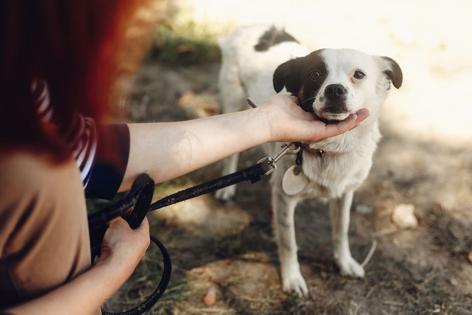My Pet World: Dog rescued from puppy mill is scared to walk on a leash
Dear Cathy,
I recently "rescued" a six-year-old poodle from a neighborhood shelter that received over 30 dogs from a large puppy mill. I love him and am determined to give him the best in life. He is very fearful and emotionally starved, but we are slowly working toward making him feel safe, comfortable and loved.
The only problem I have is he won’t walk on a leash. He has a collar, a halter, and a lightweight leash. I leave the leash on him in the backyard so he can get used to walking with it. When I pick up the leash, he immediately goes down to the ground. I put him on his feet, speak softly and lovingly to him, but as soon as I take a step, he goes down. He is not food or snack motivated.
I think it would be to his advantage to walk the neighborhood with me, especially since he has two canine "cousins" that he has come to love, and I would love to be able to include him in their neighborhood walks. Any suggestions?
— Kathy, North Island Park, New York
Dear Kathy,
In a puppy mill, it’s likely he never ever walked on leash. To help your poodle become more confident on a leash, start by building positive associations. When he is in the backyard, don’t try to walk him. Instead, sit on the ground and hold the leash. Just sit for a few minutes and then put the leash down.
Gradually increase the duration that you hold the leash over time, ensuring he remains calm and relaxed. Since he isn’t food motivated, find what he enjoys the most and use that as a reward, whether it be verbal praise or a special toy.
Gradual desensitization is also important. Keep your training sessions short to prevent overwhelming him and aim for multiple short sessions throughout the day instead of one long session. Practice indoors if the backyard is too distracting or if he associates it with fear. When he is ready, walk him around the house on the leash, giving gentle praise and encouragement. Once he’s comfortable indoors, transition back to the backyard.
Using a harness instead of a collar can sometimes make dogs feel more secure, so ensure you’re using a well-fitted harness that doesn’t cause discomfort. Incorporating his canine cousins into the training sessions may also be beneficial. Seeing other dogs walking calmly on a leash can encourage him to follow their lead.
The key is to be patient and persistent, celebrating small victories along the way. Your love and dedication are already making a significant difference in his life, and with time, he will likely become more confident and comfortable on the leash.
Dear Cathy,
I have a question regarding two, one-year-old cats, a male and a female from the same litter. The male cat belongs to me, the female cat to my mom. I am moving out into an apartment, and have plans to take the male with me, but am concerned about the two being bonded and the possible negative consequences of that.
Is a year old too late of an age to separate them? And is there a way to make separating them easier? A secondary question is: If it is safe to separate them, would it disrupt them to bring the male back to visit occasionally?
– Parker, Omaha, Nebraska
Dear Parker,
Separating bonded cats can be challenging, but not impossible. Start by separating them for short periods before the actual move. Keep them in separate rooms for a few hours each day, slowly increasing the duration.
When you move, take some of the female cat's items (like a blanket or a toy) with you, and leave behind some of his items for her. Familiar scents can provide comfort and help ease the transition.
Maintain a consistent routine in your new home and give the male cat plenty of attention and stimulation. Interactive toys, scratching posts, and regular playtime can help keep him occupied and less anxious. Keep an eye on both cats' behavior after the separation. Pheromone collars can help both with any anxiety.
Regarding occasional visits, it's generally best to avoid reintroducing the cats temporarily. Cats are territorial animals, and bringing one back into another's space can sometimes cause stress and confusion for both.
Instead, focus on helping them adjust to their new environments separately. If, after some time, you want to reintroduce them for visits, do so very cautiously and observe their reactions closely. With time and careful management, both cats can adjust to their new living situations.
_____
_____
========
(Cathy M. Rosenthal is a longtime animal advocate, author, columnist and pet expert who has more than 25 years in the animal welfare field. Send your pet questions, stories and tips to cathy@petpundit.com. Please include your name, city, and state. You can follow her @cathymrosenthal.)
©2024 Tribune Content Agency, LLC.
(c) 2024 DISTRIBUTED BY TRIBUNE MEDIA SERVICES, INC.












Comments